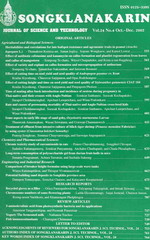ThaiScience
ThaiScience
SONGKLANAKARIN JOURNAL OF SCIENCE & TECHNOLOGY
Volume 41, No. 01, Month JANUARY, Year 2019, Pages 246 - 253
Evaluation of antibacterial, antioxidant activity and calmodulin gene expression of scoparia dulcis linn.
Netnapa Chana, Preuttiporn Supaphon, Amornrat Phongdara
Abstract Download PDF
In Thailand, Scoparia dulcis is being used as a traditional medicine. The extract displays the best inhibitory effect against Pseudomonas aeruginosa and its minimum inhibitory concentration (MIC) was 400 μg/mL followed by Escherichia coli and Staphylococcus aureus with MIC 500 μg/mL. The presence of the extract significantly protected Sf9 cells against H2O2- induced cell death. In addition, the extract also showed DNA damage inhibitory effect in a concentration-dependent manner (0.5- 4 mg/mL). However, at higher concentrations (7.5-30 mg/mL) it might induce damage to the DNA. The prevention of DNA damage differs in different parts of the plant. To support secondary metabolite synthesis in different parts of S. dulcis, we investigated the expression of the Calmodulin gene that is involved in secondary metabolite production. The Calmodulin gene showed the highest expression in the fruit. This finding justifies the use of S. dulcis in the treatment of diseases caused by bacteria and free radicals.
Keywords
Scoparia dulcis Linn., antibacterial, H2O2, DNA nicking, Calmodulin gene expressionSONGKLANAKARIN JOURNAL OF SCIENCE & TECHNOLOGY
Published by : Prince of Songkla University
Contributions welcome at : http://rdo.psu.ac.th
